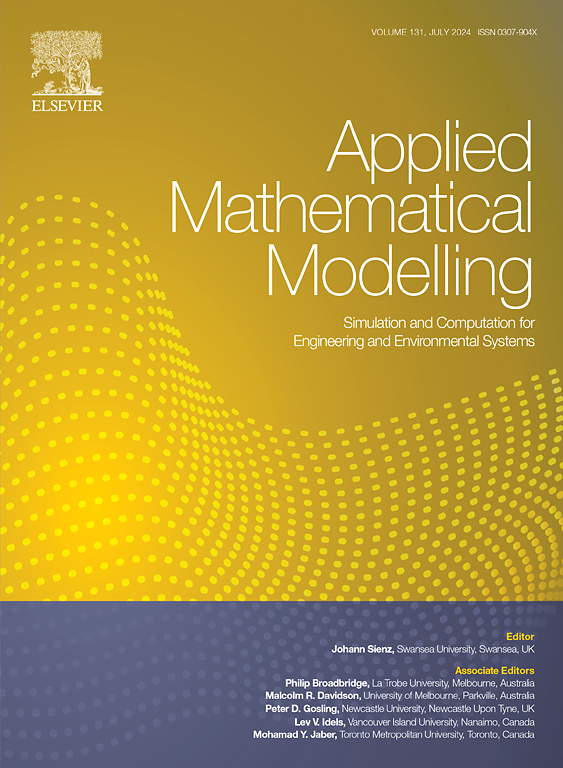Refraction and reflection patterns of an inclined turbulent conductive jet induced by a local transverse magnetic field
IF 4.4
2区 工程技术
Q1 ENGINEERING, MULTIDISCIPLINARY
引用次数: 0
Abstract
This study investigates the interaction between turbulent conductive jets and transverse magnetic fields, focusing on the effects of jet inclination angle and magnetic field strength. This phenomenon is relevant to both metallurgy and astrophysics. In metallurgy, complex localized magnetic fields are frequently used to control molten metal flows. Similarly, in astrophysics, a comparable effect occurs with relativistic jets (RJs) emitted by active galactic nuclei (AGN), where these jets can be deflected or refracted when encountering magnetic fields. In this study, it was observed that the jet undergoes refraction, meaning its initial direction changes when passing through a direct current (DC) magnetic field. This refraction is accompanied by expansion and fluctuations in the jet's mean flow. The degree of refraction was measured using a refractive index (RI), denoted as , which was related to the Stuart (magnetic interaction) number . For moderate Stuart numbers (), the refraction index followed a simple relationship, , regardless of the jet's inclination angle. At higher values (), refraction index varies with inclination due to the development of reverse flow zones adjacent to the main jet, a behavior previously reported by the authors. At certain critical values, full reflection occurs, where the jet cannot penetrate the magnetic field. When the jet is confined by conductive walls, refraction intensifies, leading to earlier full reflection. These findings provide insight into the mechanisms behind the bending and expansion of astrophysical relativistic jets, suggesting that similar magnetic interactions may influence the RJs behavior as they encounter magnetic fields in space.
局部横向磁场诱导的倾斜湍流导电射流的折射和反射模式
本文研究了湍流导电射流与横向磁场的相互作用,重点研究了射流倾角和磁场强度的影响。这一现象与冶金学和天体物理学都有关系。在冶金学中,经常使用复杂的局部磁场来控制熔融金属的流动。同样,在天体物理学中,活动星系核(AGN)发射的相对论性喷流(RJs)也会产生类似的效应,当这些喷流遇到磁场时,会发生偏转或折射。在这项研究中,观察到射流发生折射,这意味着它的初始方向在通过直流磁场时发生了变化。这种折射伴随着膨胀和射流平均流量的波动。折射率(RI)表示为n,它与斯图尔特(磁相互作用)数n有关。对于中等斯图尔特数(n≤0.5),无论射流的倾角如何,折射率都遵循n≈1−n的简单关系。在较高的数值(N>0.5)下,由于主射流附近的逆流区发展,折射率随倾角而变化,这是作者先前报道的行为。在某些临界N值时,发生全反射,此时射流不能穿透磁场。当射流受到导电壁的限制时,折射增强,导致更早的全反射。这些发现为天体物理相对论性喷流弯曲和膨胀背后的机制提供了洞见,表明当rj在太空中遇到磁场时,类似的磁相互作用可能会影响它们的行为。
本文章由计算机程序翻译,如有差异,请以英文原文为准。
求助全文
约1分钟内获得全文
求助全文
来源期刊

Applied Mathematical Modelling
数学-工程:综合
CiteScore
9.80
自引率
8.00%
发文量
508
审稿时长
43 days
期刊介绍:
Applied Mathematical Modelling focuses on research related to the mathematical modelling of engineering and environmental processes, manufacturing, and industrial systems. A significant emerging area of research activity involves multiphysics processes, and contributions in this area are particularly encouraged.
This influential publication covers a wide spectrum of subjects including heat transfer, fluid mechanics, CFD, and transport phenomena; solid mechanics and mechanics of metals; electromagnets and MHD; reliability modelling and system optimization; finite volume, finite element, and boundary element procedures; modelling of inventory, industrial, manufacturing and logistics systems for viable decision making; civil engineering systems and structures; mineral and energy resources; relevant software engineering issues associated with CAD and CAE; and materials and metallurgical engineering.
Applied Mathematical Modelling is primarily interested in papers developing increased insights into real-world problems through novel mathematical modelling, novel applications or a combination of these. Papers employing existing numerical techniques must demonstrate sufficient novelty in the solution of practical problems. Papers on fuzzy logic in decision-making or purely financial mathematics are normally not considered. Research on fractional differential equations, bifurcation, and numerical methods needs to include practical examples. Population dynamics must solve realistic scenarios. Papers in the area of logistics and business modelling should demonstrate meaningful managerial insight. Submissions with no real-world application will not be considered.
 求助内容:
求助内容: 应助结果提醒方式:
应助结果提醒方式:


